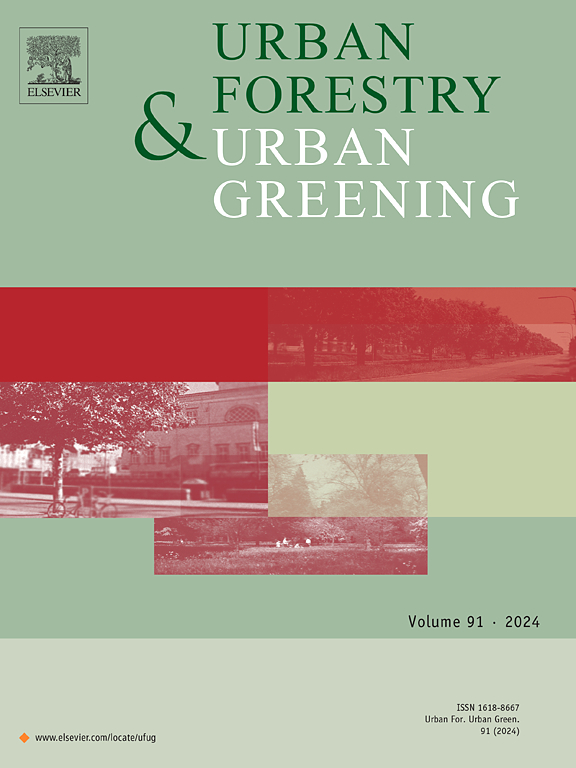Productive urban green façades – Biomass and bioenergy
IF 6
2区 环境科学与生态学
Q1 ENVIRONMENTAL STUDIES
引用次数: 0
Abstract
Green façades are increasingly implemented as heat-stress counter measures, but little is known about their biomass production rates. Although urban biomass has long been considered waste, its sustainable and cost-effective potential as a renewable bioenergy resource should be acknowledged. Thus, façade greening can be regarded as climate change mitigation. In this study, seven green façades in Berlin, Germany greened with five plant species were harvested and their annual biomass production rates were measured separating herbaceous, wooden, and fruit biomass. The bioenergetic potentials of the biomass were analyzed for conversion by combustion and via biogas. The annual biomass production rates for the wall area, ground area, and the urban quarter were estimated. H. Helix, H. lupulus, P. tricuspidata, P. coccineus, and F. baldschuanica produced 0.12, 0.20, 0.20, 0.37, and 0.64 kg DM m−2 a−1 per façade area and 3.1, 4.1, 2.5, 2.6, and 12.8 kg DM m−2 a−1 per ground area, respectively. The biomass showed higher heating values of 16.2–19.8 MJ kg−1 and methanogenic potentials of 126–238 LN kg−1. Combustion and methane production resulted in 1.6–18.3 MJ m−2 a−1 and 0.5–6.2 MJ m−2 a−1 per façade area, respectively. Green façades produce significantly more biomass per ground area than agricultural and silvicultural systems. This underscores the importance of green façades in promoting sustainable and ethical urban biomass and bioenergy production, while adding value to unused vertical surfaces without intensifying land-use competition.
生产性城市绿地-生物质和生物能源
绿色农田越来越多地作为热应力应对措施实施,但对其生物量产量知之甚少。虽然城市生物质长期以来一直被视为废物,但应承认其作为可再生生物能源的可持续和成本效益潜力。因此,滨海绿化可被视为减缓气候变化。在这项研究中,我们采集了德国柏林的7个种植了5种植物的绿地,并测量了它们的年生物量产量,分别是草本、木质和水果生物量。分析了生物质燃烧转化和沼气转化的生物能潜力。估算了墙体面积、地面面积和城市区域的年生物量产量。h .螺旋h . lupulus p . tricuspidata p . coccineus和f . baldschuanica 0.12, 0.20, 0.20, 0.37,和0.64 公斤DM m 2−−1每立面面积3.1,4.1,2.5,2.6,和12.8 公斤DM m 2−−1每地面面积,分别。生物质热值为16.2 ~ 19.8 MJ kg−1,产甲烷势为126 ~ 238 LN kg−1。燃烧和产甲烷分别产生1.6-18.3 MJ m−2 a−1和0.5-6.2 MJ m−2 a−1 / farade面积。绿色农田比农业和造林系统产生的每地面面积的生物量多得多。这强调了绿色农业在促进可持续和合乎道德的城市生物质和生物能源生产方面的重要性,同时在不加剧土地使用竞争的情况下增加未使用的垂直表面的价值。
本文章由计算机程序翻译,如有差异,请以英文原文为准。
求助全文
约1分钟内获得全文
求助全文
来源期刊

Urban Forestry & Urban Greening
FORESTRY-
CiteScore
11.70
自引率
12.50%
发文量
289
审稿时长
70 days
期刊介绍:
Urban Forestry and Urban Greening is a refereed, international journal aimed at presenting high-quality research with urban and peri-urban woody and non-woody vegetation and its use, planning, design, establishment and management as its main topics. Urban Forestry and Urban Greening concentrates on all tree-dominated (as joint together in the urban forest) as well as other green resources in and around urban areas, such as woodlands, public and private urban parks and gardens, urban nature areas, street tree and square plantations, botanical gardens and cemeteries.
The journal welcomes basic and applied research papers, as well as review papers and short communications. Contributions should focus on one or more of the following aspects:
-Form and functions of urban forests and other vegetation, including aspects of urban ecology.
-Policy-making, planning and design related to urban forests and other vegetation.
-Selection and establishment of tree resources and other vegetation for urban environments.
-Management of urban forests and other vegetation.
Original contributions of a high academic standard are invited from a wide range of disciplines and fields, including forestry, biology, horticulture, arboriculture, landscape ecology, pathology, soil science, hydrology, landscape architecture, landscape planning, urban planning and design, economics, sociology, environmental psychology, public health, and education.
 求助内容:
求助内容: 应助结果提醒方式:
应助结果提醒方式:


